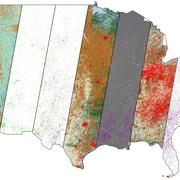Land Change Science Program
Global Islands
A new 30 meter resolution global shoreline vector and associated global islands database for the development of standardized ecological coastal units
Read ArticleHome
Changes in the environment, land use, and climate can have significant impacts on our Nation’s economy, natural resources, infrastructure, and water, food, and energy security. To strengthen our Nation’s ability to respond and adapt to these stressors, the USGS Land Change Science Program conducts research to improve understanding of rates, causes, and consequences of climate and land use change.
News
RAMPS Newsletter - Summer 2020 Edition
This season's edition of the Restoration Assessment and Monitoring Program for the Southwest Newsletter contains recent program highlights including research updates, new projects, field updates and more.
To subscribe to our newsletter, please visit: ...
Continuous Monitoring of Land Surface Change Over 30 Years Using the Landsat Record
The USGS Land Change Monitoring, Assessment, and Projection project has released a new suite of land-cover change products for the conterminous U.S.
RESEARCH BRIEF: Cost- benefit analysis of vegetation removal + seeding
Weighing costs relative to outcomes: woody and invasive plant removal followed by seeding in shrublands and woodlands.
New study by RAMPS researchers examines how the costs of vegetation treatments related to outcomes.
...
Publications
Solar and sensor geometry, not vegetation response, drive satellite NDVI phenology in widespread ecosystems of the western United States
Satellite-derived phenology metrics are valuable tools for understanding broad-scale patterns and changes in vegetated landscapes over time. However, the extraction and interpretation of phenology in ecosystems with subtle growth dynamics can be challenging. US National Park Service monitoring of evergreen pinyon-juniper ecosystems in the western...
Norris, Jodi R.; Walker, Jessica J.Boreal blazes: Biomass burning and vegetation types archived in the Juneau Icefield
The past decade includes some of the most extensive boreal forest fires in the historical record. Warming temperatures, changing precipitation patterns, the desiccation of thick organic soil layers, and increased ignition from lightning all contribute to a combustive combination. Smoke aerosols travel thousands of kilometers, before blanketing the...
Kehrwald, Natalie; Jasmann, Jeramy Roland; Dunham, Melissa E.; Ferris, David G.; Osterburg, Erich C.; Kennedy, Joshua; Havens, Jeremy; Barber, Larry; Fortner, Sarah K.Modelling marsh-forest boundary transgression in response to storms and sea-level rise
The lateral extent and vertical stability of salt marshes experiencing rising sea levels depend on interacting drivers and feedbacks with potential for non‐linear behaviors. A two‐dimensional transect model was developed to examine changes in marsh and upland forest lateral extent and to explore controls on marsh inland transgression. Model...
Carr, Joel A.; Guntenspergen, Glenn R.; Kirwan, Matthew




